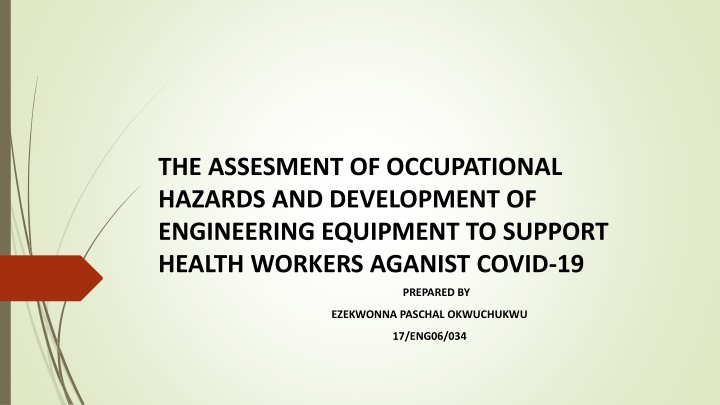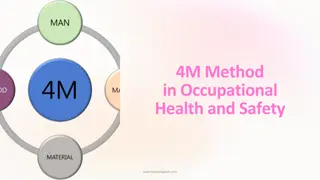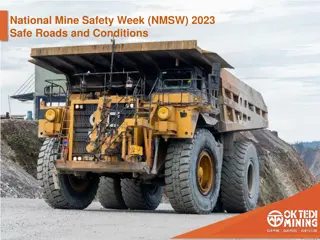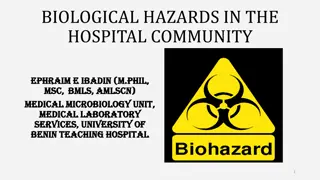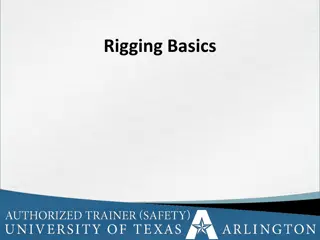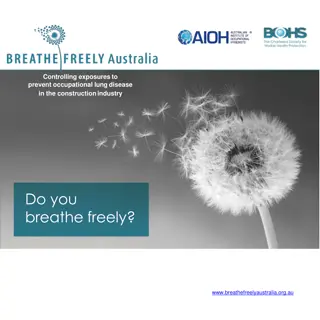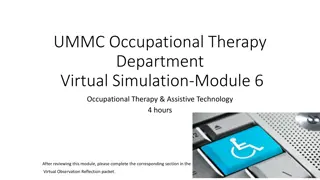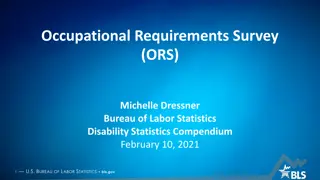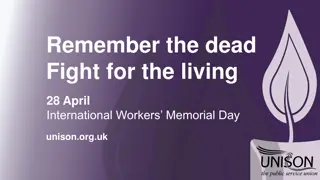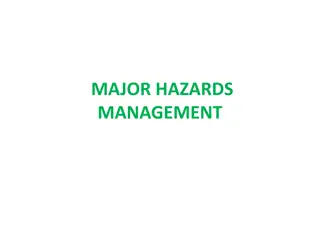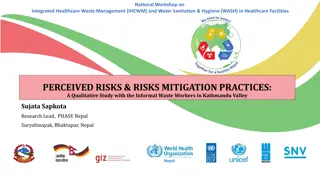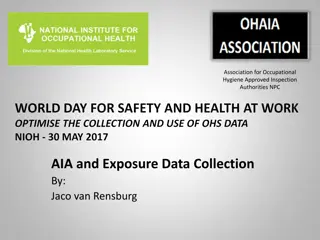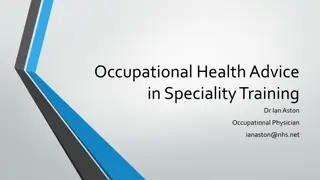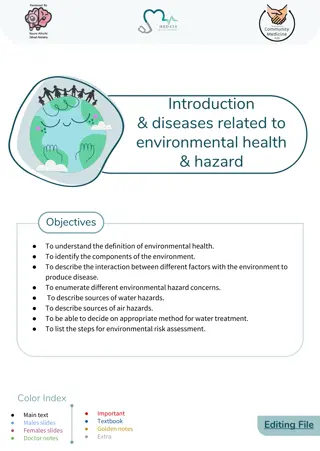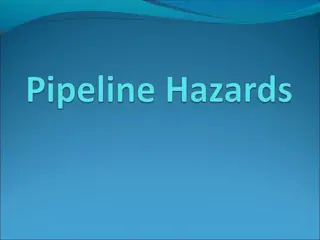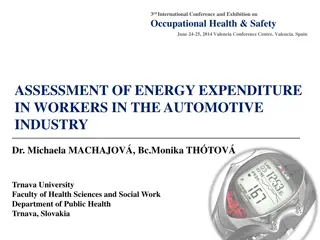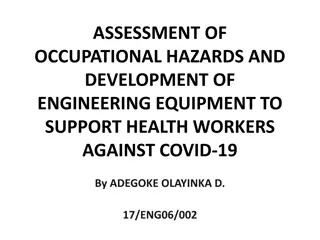Assessment of Occupational Hazards & Engineering Equipment for Health Workers Against COVID-19
Occupational hazards assessment and development of engineering equipment to support health workers against COVID-19. Topics covered include introduction, definition, engineering strategies, results, conclusion, and recommendation. Exploring the impact of coronavirus on health workers and ways to mitigate biological hazards in the workplace.
Download Presentation

Please find below an Image/Link to download the presentation.
The content on the website is provided AS IS for your information and personal use only. It may not be sold, licensed, or shared on other websites without obtaining consent from the author.If you encounter any issues during the download, it is possible that the publisher has removed the file from their server.
You are allowed to download the files provided on this website for personal or commercial use, subject to the condition that they are used lawfully. All files are the property of their respective owners.
The content on the website is provided AS IS for your information and personal use only. It may not be sold, licensed, or shared on other websites without obtaining consent from the author.
E N D
Presentation Transcript
THE ASSESMENT OF OCCUPATIONAL HAZARDS AND DEVELOPMENT OF ENGINEERING EQUIPMENT TO SUPPORT HEALTH WORKERS AGANIST COVID-19 PREPARED BY EZEKWONNA PASCHAL OKWUCHUKWU 17/ENG06/034
CONTENTS INTRODUCTION/DEFINITION CORONAVIRUS (COVID-19) ENGINEERING STRATEGIES RESULTS CONCLUSION AND RECOMMENDATION
INTRODUCTION OCCUPATION Ajob, employment, work or occupation, is a person's role in society. A person's usual or principal work or business, especially as a means of earning a living. More specifically, a job is an activity, often regular and often performed in exchange for payment ("for a living"). Many people have multiple jobs (e.g., parent, homemaker, and employee). A person can begin a job by becoming an employee, volunteering, starting a business, or becoming a parent. The duration of a job may range from temporary (e.g., hourly odd jobs) to a lifetime (e.g., judges). An activity that requires a person's mental or physical effort is work (as in "a day's work"). If a person is trained for a certain type of job, they may have a profession. Typically, a job would be a subset of someone's career. The two may differ in that one usually retires from their career, versus resignation or termination from a job. WHO IS A HEALTH WORKER A health worker is one who delivers care and services to the sick and ailing either directly as doctors and nurses or indirectly as aides, helpers, laboratory technicians, or even medical waste handlers. There are approximately 59 million healthcare workers worldwide.
CORONAVIRUS (COVID-19) Coronavirus is a family of viruses that can cause illnesses such as the common cold, severe acute respiratory syndrome (SARS) and middle east respiratory syndrome (MERS). In 2019, a new coronavirus was identified as the cause of disease outbreak that originated in china. The virus is now known as the severe acute respiratory syndrome coronavirus 2 (SARS- CoV-2). The disease it causes is called coronavirus disease 2019 (COVID-19). In March 2020, the World Health Organization (WHO) declared the COVID-19 outbreak a pandemic.
Biological hazards Biological hazard Biological agents, including microorganisms and toxins produced by living organisms, can cause health problems in workers. Influenza is an example of a biohazard which affects a broad population of workers. Those who work outdoors encounter numerous biological hazards, including bites and stings from insects, spiders, snakes and scorpions,[11][12][13] contact dermatitis from exposure to urushiol from poisonous Toxicodendron plants,[14] Lyme disease,[15] West Nile virus,[16] and coccidioidomycosis.[17] According to NIOSH, outdoor workers at risk for these hazards "include farmers, foresters, landscapers, groundskeepers, gardeners, painters, roofers, pavers, construction workers, laborers, mechanics, and any other workers who spend time outside. Health care professionals are at risk to exposure to blood-borne illnesses (such as HIV, hepatitis B, and hepatitis C)[18] and particularly to emerging infectious diseases, especially when not enough resources are available to control the spread of the disease.[19] Veterinary health workers, including veterinarians, are at risk for exposure to zoonotic disease.[20] Those who do clinical work in the field or in a laboratory risk exposure to West Nile virus if performing necropsies on birds affected by the virus or are otherwise working with infected tissue. Other occupations at risk to biological hazard exposure include poultry workers, who are exposed to bacteria and tattooists and piercers, who risk exposure to blood-borne pathogens.
Coronavirus disease (COVID-19) is an infectious disease caused by a newly discovered coronavirus. Most people infected with the COVID-19 virus will experience mild to moderate respiratory illness and recover without requiring special treatment. Older people, and those with underlying medical problems like cardiovascular disease, diabetes, chronic respiratory disease, and cancer are more likely to develop serious illness. The best way to prevent and slow down transmission is be well informed about the COVID-19 virus, the disease it causes and how it spreads. Protect yourself and others from infection by washing your hands or using an alcohol based rub frequently and not touching your face. The COVID-19 virus spreads primarily through droplets of saliva or discharge from the nose when an infected person coughs or sneezes, so it s important that you also practice respiratory etiquette (for example, by coughing into a flexed elbow).At this time, there are no specific vaccines or treatments for COVID-19. However, there are many ongoing clinical trials evaluating potential treatments.
Symptoms Signs and symptoms of COVID-19 may appear two to 14 days after exposure and can include: Fever Cough Shortness of breath or difficulty breathing Other symptoms can include: Tiredness Aches Runny nose Sore throat Some people have experienced the loss of smell or taste.
Causes Infection with the new coronavirus (severe acute respiratory syndrome coronavirus 2, or SARS-CoV-2) causes coronavirus disease 2019 (COVID-19). It's unclear exactly how contagious the new coronavirus is. Data has shown that it spreads from person to person among those in close contact (within about 6 feet, or 2 meters). The virus spreads by respiratory droplets released when someone with the virus coughs, sneezes or talks. It can also spread if a person touches a surface with the virus on it and then touches his or her mouth, nose or eyes. Risk factors Risk factors for COVID-19 appear to include: Recent travel from or residence in an area with ongoing community spread of COVID-19 as determined by CDC or WHO Close contact with someone who has COVID-19 such as when a family member or health care worker takes care of an infected person.
PREVENTION Preventive measures include: Wash your hands regularly for 20 seconds, with soap and water or alcohol-based hand rub. Cover your nose and mouth with a disposable tissue or flexed elbow when you cough or sneeze. Avoid close contact (1 meter or 3 feet) with people who are unwell. Stay home and self-isolate from others in the household if you feel unwell. Don't touch your eyes, nose, or mouth if your hands are not clean.
ASSESSMENT OF OCCUPATIONAL HAZARDS FACED BY HEALTH WORKERS WHAT IS OCCUPATIONAL HAZARD? An occupational hazard is a hazard experienced in the workplace. Occupational hazards can encompass many types of hazards, including chemical hazards, biological hazards (biohazards), psychosocial hazards, and physical hazards. In the United States, the National Institute for Occupational Safety and Health (NIOSH) conduct workplace investigations and research addressing workplace health and safety hazards resulting in guidelines.[1] The Occupational Safety and Health Administration (OSHA) establishes enforceable standards to prevent workplace injuries and illnesses.[2] In the EU a similar role is taken by EU-OSHA. Occupational hazard as a term signifies both long-term and short-term risks associated with the workplace environment and is a field of study within occupational safety and health and public health.[3] Short term risks may include physical injury, while long-term risks may be increased risk of developing cancer or heart disease.
WORKPLACE HAZARD FOR THE CONTROL FOR COVID-19 Workplace hazard controls for COVID-19 are the application of occupational safety and health methodologies for hazard controls to the prevention of coronavirus disease 2019 (COVID-19). The proper hazard controls in the workplace depend on the worksite and job task, based on a risk assessment of sources of exposure, disease severity in the community, and risk factors of individual workers who may be vulnerable to contracting COVID-19. According to the U.S. Occupational Safety and Health Administration (OSHA), lower exposure risk jobs have minimal occupational contact with the public and other coworkers, for which basic infection prevention measures are recommended, including hand washing, encouraging workers to stay home if they are sick, respiratory etiquette, and maintaining routine cleaning and disinfecting of the work environment. Medium exposure risk jobs include those that require frequent or close contact with people who are not known or suspected with COVID-19, but may be infected due to ongoing community transmission or international travel. This includes workers who have contact with the general public such as in schools, high-population-density work environments, and some high-volume retail settings. Hazard controls for this group, in addition to basic infection prevention measures, include ventilation using high-efficiency air filters, sneeze guards, and having personal protective equipment available in case a person with COVID-19 is encountered. OSHA considers healthcare and mortuary workers exposed to known or suspected person with COVID-19 to be at high exposure risk, which increases to very high exposure risk if workers perform aerosol-generating procedures on, or collect or handle specimens from, known or suspected person with COVID-19. Hazard controls appropriate for these workers include engineering controls such as negative pressure ventilation rooms, and personal protective equipment appropriate to the job task.
ENGINEERING EQUIPMENTS AND HOW THEY SUPPORT HEALTH WORKERS EQUIPMENTS the set of articles or physical resources serving to equip a person or thing. . Different jobs require different kinds of equipment. ENGINEERING EQUIPMENT engineering equipment means engineering plant and any other plant or equipment designed and constructed for the purpose of engineering operations. This refers to the tools or set of tools and/or other objects used to achieve engineering objectives. Engineering controls are strategies designed to protect workers from hazardous conditions by placing a barrier between the worker and the hazard or by removing a hazardous substance through air ventilation. Engineering controls involve a physical change to the workplace itself, rather than relying on workers' behavior or requiring workers to wear protective clothing. Engineering controls is the third of five members of the hierarchy of hazard controls, which orders control strategies by their feasibility and effectiveness. Engineering controls are preferred over administrative controls and personal protective equipment (PPE) because they are designed to remove the hazard at the source, before it comes in contact with the worker. Well-designed engineering controls can be highly effective in protecting workers and will typically be independent of worker interactions to provide this high level of protection. The initial cost of engineering controls can be higher than the cost of administrative controls or PPE, but over the longer term, operating costs are frequently lower, and in some instances, can provide a cost savings in other areas of the process. Elimination and substitution are usually considered to be separate levels of hazard controls, but in some schemes they are categorized as types of engineering control. The U.S. National Institute for Occupational Safety and Health researches engineering control technologies, and provides information on their details and effectiveness in the NIOSH Engineering Controls Database. Engineering emerging
Engineering emerging technologies could aid health workers in many ways including the five listed below Remote Healthcare Remote patient monitoring speeds up testing for the infection, followed by tracing and isolating potential carriers. Analysing behavioural and biometric data from wearable improves the accuracy of detecting positive cases of COVID-19. With public health experts reiterating the need for social distancing, tele-nursing and telemedicine applications fill the gap created by a shortage of medical professionals. Connected health platforms allow doctors and patients to remotely engage via online conversational interfaces and digital medical assistance. Below are 6 of the most relevant solutions that enable a faster and more efficient response to the COVID-19 pandemic in the fields of: Remote Monitoring Telehealth Respiratory Monitoring Digital Stethoscope Mental Health Chat bots Wearable Sensors Prevention Measures Inside hospitals, doctors, nurses, and health staff use interactive real-time mobile apps to stay updated about infected patients and their treatment.
CONCLUSION/ RECOMMENDATIONS CONCLUSION AND RECOMMENDATION I strongly believe that the above mentioned strategies of engineering in handling the pandemic situation are effectively been carried out to help the victims as well as the rest of the world in taking preventive measures. I also believe that the above mentioned results have also taking great effect in both sides of the world (victims and non-victims). RECOMMENDATION With respect to the current situation, I recommend the following: People should strictly adhere to the WHO instructions and guidance. People should follow and obey the country s order and protocols. Governments in the country should take responsibility and provide for her citizens, especially those with little or no means of provision. People should use this medium to be creative and engage in one form of activity (legal) or the other from their various homes. every person should engage in prayers and worships and to call upon their LORD for help. We should wash our hands regularly and avoid social distancing
